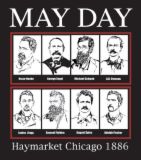From an article in the US radical newsletter Dissident Voice (1.5.07) by Sharat G Lin

Over 1.5 million people took part in May Day demonstrations in 2006 in what amounted to one of the single largest days of protest in US history. Many also participated in a general strike by refusing to conduct business, go to work, or attend school. The protests were called by immigrants groups and immigrant solidarity groups as a national day of action against House Resolution 4437, which would have criminalized those assisting undocumented immigrants as alien smugglers
and turned undocumented status from a civil violation to a federal aggravated felony.
The importance of May Day for immigrant communities in the US is not only of demanding fundamental constitutional rights for immigrants, but for economic rights as immigrant workers. It was chosen because May Day is a living tradition in the Latin American countries from which most of the undocumented immigrants in the US come. May Day is also an international day of labor solidarity.
May Day itself was born, in part, out of fear of police raids on immigrant workers. In 1884 the Federation of Organized Trades and Labor Unions, predecessor of the American Federation of Labor (AFL), called for an eight-hour workday. When implementation appeared unlikely, a general strike was called in Chicago on May 1, 1886. On that day, some 80,000 workers marched down Chicago’s Michigan Avenue in what is generally recognized as the first May Day parade. In the succeeding days, supporting strikes broke out in other cities, such as Milwaukee, Cincinnati, and New York City.
On May 3, four striking workers were killed by police at the McCormick Reaper Works in Chicago. At an evening rally on May 4 in Haymarket Square, called to protest the killings, police moved in to disperse the crowd when a bomb went off, killing seven policemen. Police retaliated by firing into the crowd of workers, killing and wounding an unknown number of civilians.
Determined to crush the labor agitations, police interrogations and arrests went on through the night and the ensuing days. Homes of workers, most of whom were immigrants from Europe , were raided in the middle of the night. Hundreds of immigrants were rounded up without charges. A police reign of terror descended on the organized workers of Chicago and their families.
Eight people, including five German immigrants, were eventually charged and convicted for the deaths of the policemen, even though no evidence was ever presented directly linking them to the bombing in Haymarket Square. Four of the defendants were publicly hanged in 1887.
In Paris in 1889, the International Workingmen’s Association (Second International) called for worldwide demonstrations on May 1, 1890, commemorating the struggle of Chicago workers. The international tradition of May Day was born.
